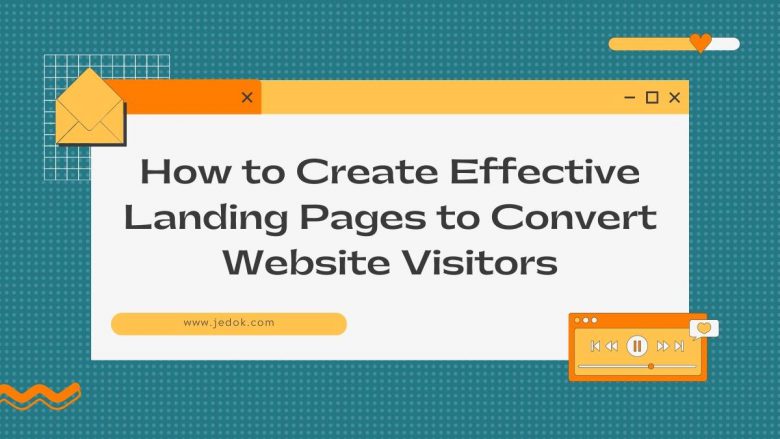
Creating effective landing pages is an essential aspect of any digital marketing strategy. A well-designed landing page can help convert website visitors into customers and increase your conversion rate. Here are some tips to create landing pages that are optimized for conversions.
1. Define your target audience
Understanding your target audience is essential for creating an effective landing page to convert website visitors. Knowing who you are targeting before designing a landing page allows you to customize the content and design of the page so that it speaks directly to their needs and interests.
When identifying your target audience, ask yourself questions such as what their pain points are, what they need from your product or service, and why they would be interested in engaging with your business. Answering these questions can help you create an effective landing page that will draw users in and encourage them to take action.
As the first step towards converting website visitors into paying customers, creating an effective landing page should be a priority for any business looking to maximize its online presence. Take time to define your target audience and craft a well-designed landing page tailored specifically to them — this will ensure more conversions down the line!
2. Keep it simple
Creating an effective landing page to convert website visitors is essential for any business. A cluttered and complicated landing page can overwhelm potential customers, causing them to leave the site without a conversion. To avoid this problem, businesses should keep the design of their landing page simple and clean.
A basic but effective landing page should have minimal distractions and be easy to navigate. The content should be clearly laid out with a headline that captures attention, concise text that provides pertinent information about products or services, and visually attractive images that draw in potential customers. Additionally, the main call-to-action should stand out from other elements on the page so it’s easy for users to find what they need quickly.
By using a simple design for their landing pages, businesses can ensure visitors don’t become overwhelmed by too much information or visuals.
3. Use clear and persuasive language
When it comes to creating an effective landing page, the language you use is of utmost importance. Clear and persuasive language can be the difference between success and failure when converting website visitors into customers. Your language should appeal directly to potential customers, making them feel that your product or service is what they need to solve their pain points.
It’s essential to use concise yet descriptive words that evoke emotion and draw readers in. Remember: You only have a few seconds to make an impression on website visitors so make sure your wording is engaging and speaks directly to the customer’s needs. Aim for short, simple sentences with crucial phrases that highlight the benefits of your product or service – this will help convince customers that it truly is the best option for them. Additionally, avoid any unnecessary jargon or technical terms as this could confuse potential customers instead of persuading them towards conversion.
4. Include compelling visuals
When creating an effective landing page, visuals are key in capturing the attention of website visitors and driving them to take action. High-quality images, videos, and infographics can work together to make your landing page more interesting and appealing to potential customers.
Including compelling visuals like large photographs or animations will help draw the user’s eye and get them engaged with your content. Utilizing graphics that relate directly to what you’re offering on your landing page also helps create a deeper connection with the consumer. Additionally, visual elements can be used as a call to action by guiding users through the buying process or providing clear instructions on how to proceed.
To ensure maximum conversion rates, create visuals that are relevant to the product or service being offered on the landing page.
5. Optimize for mobile
As more and more internet traffic shifts to mobile devices, businesses need to optimize their landing pages for the mobile user experience. An effective landing page can help convert website visitors into customers, so it’s important to ensure that your content is tailored for the mobile platform. By optimizing your landing page for mobile users, you can increase conversions and provide a better user experience.
When creating an effective landing page on a mobile device, there are several key elements to consider. Utilizing responsive design allows webpages to automatically adjust based on the size of the screen they are being viewed on; this ensures that all content fits within the viewport of any device used. Additionally, using concise messaging will help keep visitors engaged with clear calls to action that drive them toward completing their desired goals.
6. Make the CTA prominent
For any website trying to convert visitors into customers, having an effective landing page is essential. A landing page is a single web page that appears in response to clicking on a search engine-optimized result or an online advertisement. It’s important to make sure the most important element of your landing page, the Call To Action (CTA), stands out and is easy to find.
Using contrasting colors for the CTA will help draw attention to it and ensure that visitors easily spot it among other elements on your page. Making use of whitespace around the CTA can also help, as too much clutter can make it difficult for people to identify what they should do next. Additionally, using arrows, shapes or icons can help guide people’s eyes toward the CTA; this helps them understand how they should interact with your website and encourages them to click on it.
7. Test, test, and test again
Test, test, and test again; this is the mantra of those looking to create an effective landing page that converts website visitors into customers. Testing helps to determine what works and what doesn’t so businesses can maximize their return on investment in terms of sales. A/B testing is one of the most powerful ways to test a landing page’s effectiveness; it involves creating two versions of a web page or application with different designs, content, or elements, then comparing them to see which performs better.
A/B testing allows businesses to compare two different versions of the same landing page side-by-side and determine which version resonates more effectively with their target audience.
Conclusion
Creating an effective landing page requires a combination of design, language, and strategy. By following these tips and continually testing your landing page, you can optimize your website and increase conversions.


